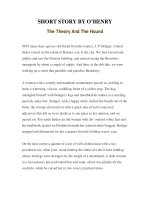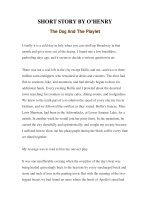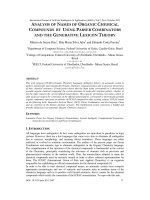DNA by Design. Stephen Meyer and the Return of the God Hypothesis
Bạn đang xem bản rút gọn của tài liệu. Xem và tải ngay bản đầy đủ của tài liệu tại đây (97.19 KB, 19 trang )
P1: IRK/IRK P2: JZP
0521829496c07.xml CY335B/Dembski 0 521 82949 6 April 2, 2004 21:3
7
DNA by Design?
Stephen Meyer and the Return of the God Hypothesis
Robert T. Pennock
In his keynote address at a recent Intelligent Design (ID) conference at
Biola University, ID leader William Dembski began by quoting “a well-known
ID sympathizer” whom he had asked to assess the current state of the ID
movement. Dembski explained that he had asked because, “after some initial
enthusiasm on his part three years ago, his interest seemed to have flagged”
(Dembski 2002). The sympathizer replied that
[t]oo much stuff from the ID camp is repetitive, imprecise and immodest in its
claims, and otherwise very unsatisfactory. The ‘debate’ is mostly going around in
circles. (Dembski 2002)
Those of us who have been following the ID or “Wedge” movement since it
coalesced around point man Philip Johnson during the early 1990s reached
much the same assessment of its arguments years ago. In something of an
understatement, Dembski told his supporters (the conference was closed
to critical observers) that “the scientific research part of ID” was “lagging
behind” its cultural penetration. He noted that there are only “a handful of
academics and independent researchers” currently doing any work on the
scholarly side of ID, and offered some suggestions to try to rally his troops
1
(Dembski 2002). We will have to wait to see if anything comes of this call,
but judging from ID’s track record, it seems unlikely. This chapter is a look
back at nearly a decade and a half of repetitious, imprecise, immodest, and
unsatisfactory arguments. So that our review does not entirely circle over old
ground, I propose that we look at the ID arguments through the writings of
Stephen C. Meyer. Meyer is certainly one of the core workers Dembski had
in mind, but his work has so far received little critical attention.
Meyer is the longtime director of the Discovery Institute’s Center for the
Renewal of Science and Culture,
2
which is the de facto headquarters of
the Wedge movement. With publications going back to the mid-1980s that
helped to lay the groundwork for the Wedge arguments, Meyer was one of
130
P1: IRK/IRK P2: JZP
0521829496c07.xml CY335B/Dembski 0 521 82949 6 April 2, 2004 21:3
DNA by Design?
131
the earliest leaders of the movement and has continued to play a central
role. As we will see, he had already published an attack on evolution that
charged it is based upon naturalistic assumptions – the centerpiece of the
ID attack that Philip Johnson would begin to press in 1991 – even before
he was introduced to Johnson in 1987 (Meyer 2001). Meyer was coauthor
of a special philosophy section in Of Pandas and People, the ID textbook
supplement for junior high and high school biology courses that tries to
make the case that ID is legitimate science (Hartwig and Meyer [1989]
1993). He also takes a leading role in the movement’s persistent lobby-
ing to get ID into the public schools, testifying at congressional and other
hearings.
3
As part of ID’s lobbying efforts, Meyer is an active writer of op-ed pieces. In
two editorials written in May and July of 1996 –“Limits of Natural Selection
a Reason to Teach All Theories,” in the Tacoma News Tribune (Meyer 1996b)
and “‘Don’t Ask, Don’t Tell’ in Biology Instruction,” in the Washington Times
(Meyer 1996a) – Meyer (in the first article) defended teaching anti-
evolutionism in the Sultan, Washington schools and (in the second) attacked
the way California’s science guidelines recommended that teachers help stu-
dents with religious objections to science. Reading these and other op-ed
pieces gives a clear picture of the points that the Wedge wants to hammer
home.
In both articles, Meyer faults biology textbooks for presenting only “half
of the picture,” leaving out information about the Cambrian explosion that,
he says, confirms a pattern of abrupt appearance rather than an evolutionary
process. These texts purportedly failed to define “evolution” adequately – it
can refer, he claims, to anything from “trivial” microevolutionary change
to “the creation of life by strictly mindless, material forces”–and they
failed to mention scientists who reject evolution in favor of “alternative the-
ories,” such as Intelligent Design. He cites ID theorist Michael Behe and his
idea that the “irreducibly complex” bacterial flagellum provides evidence
against the “superstitions” of the self-assembly of life. He criticizes biologists
(mentioning Douglas Futuyma and Kenneth Miller) who, he says, make no
attempt to hide the anti-theistic implications of Darwinism.
Meyer does not just make the same points in both articles; the paragraphs
discussing these main ideas, comprising over two of the three pages of the
July article, are actually copied word for word from the May article. We will
reply to Meyer’s other points along the way, but here let us just note that
Darwinian evolution has “anti-theistic” implications only for those who think
they already know, rather specifically, what God did and did not do. Meyer’s
misrepresentation of Miller makes sense only given ID’s own narrow view,
since Miller is a Christian theist who explicitly rejects the contention that
Darwinian evolution is anti-theistic (Miller 1999).
In a 1998 op-ed piece in Spokane’s Spokesman-Review –“Let Schools Pro-
vide Full Disclosure” (Meyer 1998) – Meyer gave advice to school board
P1: IRK/IRK P2: JZP
0521829496c07.xml CY335B/Dembski 0 521 82949 6 April 2, 2004 21:3
132
Robert T. Pennock
members in Post Falls, Washington, some of whom wanted to accommo-
date parents who were pressing to teach creationism. Biblically based Young
Earth creationism would be “legally problematic,” he said, but the Intelligent
Design approach could probably escape a legal challenge. Again, following
this introduction, most of the paragraphs are repeated verbatim from the
earlier articles, without citation.
Nor has Meyer changed his cut-and-paste approach in subsequent years.
4
A few weeks ago (as I write this), most of the same core paragraphs were
copied into yet another article by Meyer, titled “Darwin Would Love This
Debate” (Chapman and Meyer 2002) in the June 10, 2002, issue of the
Seattle Times. This time Meyer addresses the controversy over the proposal
under review by the Ohio Board of Education to include ID in the sci-
ence curriculum in that state.
5
Interestingly, a couple of minor changes
do appear in these paragraphs over the course of the six years since the
first piece appeared, which help us to address a second point in Meyer’s
challenge.
In the 1996 op-ed pieces, Meyer claimed that “none of the standard high
school biology texts even mentions the Cambrian Explosion” and suggested
that science educators had omitted it deliberately. “Scientific literacy,” he
opined “requires that students know all significant facts whether or not they
happen to support cherished theories” (Meyer 1996a, 1996b). The impli-
cation is that scientists are withholding information about the Cambrian
explosion in order to protect evolutionary theory. However, it is hardly the
case that scientists view the Cambrian radiation as an embarrassing, unsolv-
able problem for evolution, as ID theorists purport, and the suggestion of a
conspiracy of silence is absurd. One can find any number of discussions of
the Cambrian radiation in the scientific literature, and new studies regularly
increase our understanding of that interesting evolutionary episode. This
is no skeleton in the closet, kept hidden away from students, as even Meyer
is increasingly forced to admit. In his 1998 op-ed piece, he changed “none
of the standard high school biology texts” to “only one”; in the 2002 piece,
he was forced to modify it to “few.” Science, we see, is quite open about its
theories.
ID theorists, by contrast, are very close-mouthed about their own views.
If evolution really cannot hope to explain the Cambrian explosion, and
ID theorists can do better, one would expect them to show how. However,
no “alternative theory” is forthcoming. ID leaders who are Young Earth
creationists – such as Paul Nelson, Percival Davis, and others – do not even ac-
cept the scientific dating of the Cambrian. However, even the Old Earthers,
such as Behe and presumably Meyer, have offered no positive account.
Is their view that the “at least fifty separate major groups of organisms”
6
(note Meyer’s pointed claim of separateness) were separately created at that
time? What about those phyla that arose before or afterward? And why the
invariable focus at the arbitrary level of the phylum; isn’t it rather the origin
P1: IRK/IRK P2: JZP
0521829496c07.xml CY335B/Dembski 0 521 82949 6 April 2, 2004 21:3
DNA by Design?
133
of species, which is what Darwin explained, that is more pertinent? What
about the vast numbers of species that arose in the subsequent half-billion
years, or in the prior three billion? According to ID theory, even the small-
est increase in genetic information must be the result of the “insertion of
design.” Although their view would thus seem to require countless such in-
sertions, they decline to say where, when, or how this happens. The biologist
Kenneth Miller asked Dembski and Behe this question point blank during a
debate at the American Museum of Natural History, and neither was willing
to take a stand on even one specific point in time at which this supposedly
occurred (Milner et al. 2002).
The pattern of vagueness and evasion regarding the specific theoretical
commitments or possible tests of ID is pervasive. In response to my direct
questions during the same debate, Behe refused to answer whether a pro-
posed experiment would suffice to identify whether a system met his notion
of “irreducible complexity” (he said he smelled a trap), and Dembski would
not even take a stand on the age of the Earth (Milner et al. 2002). One
could cite numerous similar examples. I have not seen the chapter that
Meyer is writing on the Cambrian explosion for the present volume, but I
encourage readers to check whether he departs from the pattern and offers
any specific positive account. If ID is to have even a shot at being a real
scientific alternative, one should expect to see some precise, testable (and
eventually tested) hypotheses that answer the obvious questions: what was
designed and what wasn’t; and when, where, how, and by whom was design
information supposedly inserted?
7
Although his Discovery Institute biography describes Meyer as the author
of “numerous technical articles,” the group does not list or include any of
these in its database of his writings, as one would expect if they involved ID
research, but instead calls attention to his op-ed pieces. However, his influ-
ence runs far deeper than this would suggest. As one of the philosophers
who dominate the ID movement, Meyer’s work on the epistemological pre-
suppositions of the evolution/creation debate has helped to define the core
features of the movement from its very inception.
In “Scientific Tenets of Faith,” Meyer argues that science is based upon
“foundational assumptions of naturalism” that are as much a matter of faith
as those of “creation theory” (Meyer 1986). His argument prefigures by
several years the argument that would make Philip Johnson famous, that
scientific naturalism is akin to religious dogma and that the assumptions of
creation theory should supplant it.
Meyer makes the same error of imprecision that Johnson later would
make on this point, failing to distinguish metaphysical from methodological
naturalism. The former holds that the world is a closed system of physical
causes and that nothing else exists. This rebuts another of Meyer’s charges in
his op-ed pieces, because evolutionary biology makes no claim about “strictly
P1: IRK/IRK P2: JZP
0521829496c07.xml CY335B/Dembski 0 521 82949 6 April 2, 2004 21:3
134
Robert T. Pennock
mindless, material forces” in such a metaphysical sense. Science holds to
naturalism only in the more modest methodological sense – that is, in not
allowing itself to appeal to miracles or other supernatural interventions that
would violate natural causal regularities – and remains neutral with regard
to metaphysical possibilities. Moreover, these methodological constraints of
order and uniformity are not held dogmatically, but are based upon sound
reasons that ground evidential inference (Pennock 1996).
Unmindful or perhaps unaware of this crucial distinction, Meyer writes
of the “necessity of making intelligent foundational assumptions” that can
“lend explanation and meaning to the necessary functions of Inquiry”
(Meyer 1986), but thinks that these are just a matter of faith. As noted,
he thinks the assumptions of creation theory are at least as good as those
of science. Significantly, in making this point, Meyer draws a direct connec-
tion to the battle in Arkansas during the early 1980s regarding legislation
mandating balanced treatment of evolution and a purportedly scientific the-
ory of creation. Meyer claims that the naturalistic assumptions underlying
science put it on a par with creation theory.
8
[T]hese foundational assumptions are not unlike the much scorned “tenets of faith”
whose detected presence in creation theory first disqualified it as legitimate science
in an Arkansas federal court three years ago. This observation neither suggests nor
repudiates a defense of creation theory as legitimate science. It does, however, assert
that from the definition offered by the American Civil Liberties Union ...science
itself does not qualify as legitimate science. (Meyer 1986)
By neglecting the distinction noted above, Meyer fails to see that scientific
naturalism is not taken on faith; rather, it is a working hypothesis that is
justified, in part, by science’s continued success. It is conceivable that in the
long run it will fail, but so far the method shows no signs of weakening and
every sign of increasing strength.
The claim of generic equivalence (which we see is false) with regard to
the need for some presuppositional basis is only the initial part of the ID
program. Rejecting naturalism and any evolutionary account as a basis for
the possibility of human knowledge, Meyer and other ID theorists turn to
the alternative biblical presuppositions that they believe must be put in place
in order to ground claims of truth:
Given the current and historical difficulty human philosophic systems have faced
in accounting for truth as autonomous from revelation, scientists and philosophers
might be most receptive to systems of thought that find their roots in Biblical theol-
ogy. (Meyer 1986)
That is to say, Meyer doubts that there could be any warranted basis for
truth claims apart from revelation and Christian assumptions. Like ID advo-
cate Alvin Plantinga (whose entire epistemology is based upon a Christian
presuppositionalism), Meyer holds that human knowledge can be justified
P1: IRK/IRK P2: JZP
0521829496c07.xml CY335B/Dembski 0 521 82949 6 April 2, 2004 21:3
DNA by Design?
135
only on the assumption that God designed the human mind and that it
transcends the material world.
9
He writes:
The Judeo-Christian scriptures have much to say about the ultimate source of human
reason, the existence of a real and uniformly ordered universe, and the ability present
in a creative and ordered human intellect to know that universe. Both the Old
and New Testaments define these relationships such that the presuppositional base
necessary to modern science is not only explicable but also meaningful. (Meyer
1986)
Appealing to a “real and uniformly ordered universe” is just what method-
ological naturalism says scientists must do, but ID theorists are wrong to
think that one must ground this constraint in scripture. Indeed, taking
their biblical route actually subverts that necessary base of presumed or-
der and uniformity, because it assumes, to the contrary, that it is broken by
the Designer’s creative interventions.
We shall return to a consideration of ID theory’s proposal that a “theistic
science” (as Johnson calls it) is a better presuppositional basis for warranted
knowledge, but first let us briefly examine the claim that such a scriptural
assumption is necessary not only to make science explicable, but also to
make it “meaningful.”
Why does all this matter? In Tower of Babel (Pennock 1999, Chapter 7), I
explained how Johnson and others in his movement see not only a point
of science but also the meaning of life itself as being at stake. Among other
things, they believe that if evolution is true, then there is no ground for
moral values. This is not a peripheral issue involving their motivation, but
an essential part of their philosophical argument. That God created us for
a purpose is, for them, the necessary foundation for true human moral-
ity and proper social order. At the conclusion of the article just consid-
ered, immediately following his statement about the scriptural presuppo-
sitional grounding of their view of science, Meyer adumbrates the moral
issue:
Moreover all of us would do well to reflect on the scriptural axiom that “in Him all
things hold together,” and further reflect on the serious consequences to a society
and culture that divorce spiritual thought not only from moral considerations but
scientific ones as well. (Meyer 1986)
We find a further elaboration of this Christian assumption of the ID view
in an article Meyer wrote in collaboration with Charles Thaxton, another
important early leader of the ID movement.
In “Human Rights: Blessed by God or Begrudged by Government?,”
Thaxton and Meyer focus not on abortion, divorce, homosexuality, or the
other purported evils that Johnson discusses, but on the notion of human
dignity as the basis for human rights. They see human dignity as arising
P1: IRK/IRK P2: JZP
0521829496c07.xml CY335B/Dembski 0 521 82949 6 April 2, 2004 21:3
136
Robert T. Pennock
necessarily from the idea that human being are the glory of God’s Creation.
Here is how they make the argument:
Historically, Western society has derived its belief in the dignity of man from its
Judeo-Christian belief that man is the glory of God, made in his image. According to
this view, human rights depend upon the Creator who made man with dignity, not
upon the state. (Thaxton and Meyer 1987)
This perspective and language would show up several years later in the
“Wedge Document”–the manifesto from the Center for the Renewal of
Science and Culture, by then under Meyer’s directorship, that laid out the
ideological foundations and strategic plans of the ID movement. Thaxton
and Meyer’s article continues by contrasting the traditional Judeo-Christian
view with what they say is the contemporary scientific view “that promulgates
a less exalted view of man,” in which he is merely a material being “cast
up by chance in an ...impersonal universe” (Thaxton and Meyer 1987).
Their thesis that the modern scientific worldview is a barren materialism
that stands in opposition to the Judeo-Christian view also appears as the
key point of the ID Wedge manifesto, which pledges “nothing less than the
overthrow of materialism and its cultural legacies” and the renewal of “a
broadly theistic understanding of nature.”
10
Thaxton and Meyer say that according to the modern view, “only man’s
material complexity distinguishes him from the other biological structures
that inhabit the universe” (Thaxton and Meyer 1987), and they claim that
this is inadequate to ground human rights. They have no truck with the
possibility that moral rights could apply to nonhuman animals. Indeed,
they don’t want to consider man an animal at all; they believe it is critical
that there be something that is “distinctively human,” for otherwise it would
“relegat[e] man to the level of animals” (Thaxton and Meyer 1987). Their
goal of keeping human beings categorically distinct from animals goes hand
in glove with their theological grounding of dignity, and from this it is for
them but a small step to the rejection of biological evolution.
Thaxton and Meyer briefly consider the argument of those who promote
“merely reiterating the Judeo-Christian doctrine of creation” as a “useful
fiction,” but reject it on the ground that no merely fictional doctrine will
suffice to “rescue man from his current moral dilemma” (Thaxton and
Meyer 1987). So, what will save man? Not belief alone. Nothing less than
the truth of Divine creation. They put it this way:
Judaism and Christianity do not teach that the doctrine of man’s creation in the
Divine image establishes his dignity. They teach that the fact of man’s creation has
established human dignity. (Thaxton and Meyer 1987)
It is this teaching upon which their entire argument turns. To emphasize
the point, they immediately restate it as their central, major thesis:
Only if man is (in fact) a product of special Divine purposes can his claim to distinctive
or intrinsic dignity be sustained. (Thaxton and Meyer 1987)









